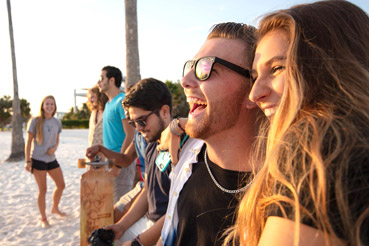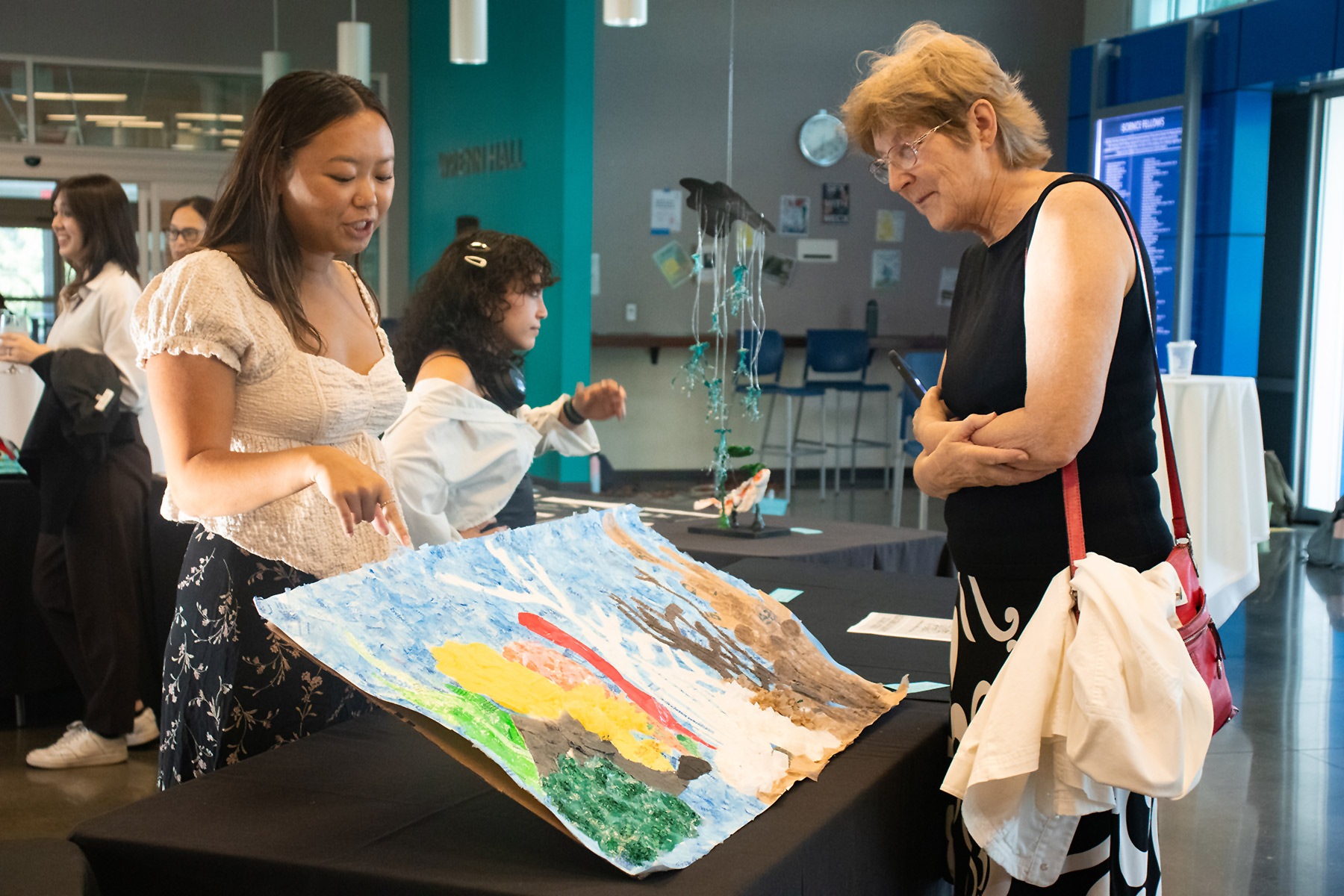More than 20 artists stood in Eckerd College’s James Center for Molecular and Life Sciences explaining their brightly colored canvases, sculptures, weavings and photography that told the sad story of the detrimental effects of single-use plastics on the environment.
The second Used Once, Lasts Forever Art Show, curated by the Reduce Single-Use Project at Eckerd College, invited all comers to display their best works made of found or recycled plastics to spread awareness and possibly earn one of several $100 prizes from an art jury on April 17.
“The last show was in 2019, and we hope to make it an annual event going forward,” says Amy Siuda, Ph.D., an associate marine science professor.
Siuda’s Reduce Single-Use co-director Shannon Gowans, Ph.D., professor of biology and marine science, offered remarks before introducing Eckerd College President James Annarelli, Ph.D.
Annarelli marveled at the creativity of the student and community works, and pointed out the timeliness of the message.
The jury included Associate Professor of Environmental Studies Joanna Huxster, Ph.D.; Art Instructor Betsy Orbe Lester ’93; Assistant Professor of Music Leslie La Barre, DMA; and Vanessa Moore, the manager of Sans Market, a local zero-waste market in St. Petersburg. Of the five categories, only one—People’s Choice—was based on the votes of attendees.
A 3-foot clear plastic peacock titled Plastic, Reduce, Reuse, ReBirdth took its artist team months to collect enough material for. Robyn Bull, a senior psychology student from Sandton, South Africa, and Jack Gregson, a senior marine science student from Newtown, Connecticut, were awarded Best Use of Plastic for their efforts.
“I think we put a lot of heart and effort into making this, and we tried to find a useful, impactful piece for this art,” Robyn explained. But post-show housing for the big bird was still in question at the end of the event.
“I think he is going to stay in our room until we find him a good home,” she decided.
Yarrow Bercovici-Biotti got a birthday surprise when her piece, Shark Tank, won the award for Most Aesthetic. The cardboard sharks of differing species stuffed to the gills with plastic bags swam freely on the wooden display wall in Wrenn Hall.
“I want to go into a career of using art to spread awareness of environmental issues, so to have this awarded was really cool,” exclaimed the sophomore environmental studies student from Ashburnham, Massachusetts. “I put a lot of time into making the sharks and thinking about how to use materials that I would have thrown away otherwise.”
Sara Hopkins’s piece, A Pelican—winner of Best Communication, required viewers to see it from both sides. On one side, the sculpture was a female pelican of nesting age, and on the other side, her innards revealed swallowed plastic trash. Sara, a first-year creative writing and environmental studies student from Hopatcong, New Jersey, intimates that things may look fine on the outside, but death could be imminent if the plastic problem isn’t addressed.
“I did put in a lot of work so I am very grateful,” Sara says. “I’m just really happy that my message came across and can help people think about single-use plastics. They are still here. They are not going anywhere in our lifetime.”
Maggie Taishoff, a senior human development student from McLean, Virginia, used materials collected from her summer research trip to Cambodia to study human trafficking with former Human Development Professor Nancy Janus, Ph.D., to create the Global Awareness–winning piece The Cambodia Experience. The giant canvas featured important landmarks and cultural icons of the Asian nation covered in bottle caps, candy wrappers and other pieces of found plastic.
“It feels incredible to win on a piece that I have worked so long on and had a lot of feelings when painting it because of my time in Cambodia,” Maggie recalls. “The research we did had an impact on my passion for human rights and environmental rights.”
Voters selected Milena Lynch’s Jellies: Or So the Turtles Think for the People’s Choice award. The suspended mobile featuring blue plastics shredded and curled to resemble jellyfish was brilliantly named.
The first-year marine science student from Winter Garden, Florida, says she is excited to be in a place where this type of science communication is possible, because the stories need to be told often and creatively to penetrate.
“I feel like the art piece speaks for itself,” she says. “A lot of people were asking how I made it.”
















